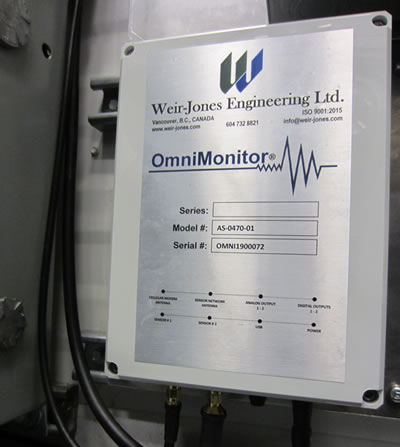
 PRODUCTS / AQUISITION
PRODUCTS / AQUISITION
OmniMonitor®

Increased focus on worker and public safety has dramatically increased condition monitoring and failure prediction in safety critical applications. These applications have varying sensing requirements although the basic operational requirements of the condition monitoring and event prediction system is similar. As such, Weir-Jones has introduced the OmniMonitor® - low-cost, stand-alone embedded hardware platform that may be used in a variety of safety critical applications for condition monitoring and failure prediction. Each application has the same data acquisition and control hardware with the exception of the connected sensors and software algorithms.
System Details
The OmniMonitor® consists of three separate technologies combined to operate as a flexible condition monitoring and event prediction system ‒ data acquisition technology, sensor technology and event prediction software technology. A diagram of the system and environment is shown below:

The system software consists of proven condition monitoring and event/failure prediction algorithms for many applications:
| Operating System | Linux |
| Network protocol | TCP/IP v4 with dynamic IP address |
| Architecture | Multi-tasking in one of two modes: continuous real-time data acquisition and recording or event-triggered data acquisition and recor.d ing |
| Alarm events | Capable of distinguishing many event signatures and failure mechanisms. Thresholds are programmable and remotely configurable over the Internet with set levels of control. |
| Self diagnostics | Basic health monitoring of system, daily check-in with system health and data exceeding thresholds. Auto-alarm by exception if monitoring system component is damaged or compromised. |
| Power modes | The device will automatically switch from low power mode to full power mode if data exceeds thresholds and remain in this mode until the observation is acknowledged by a response from an external server. In low power, the device will check in once per day and push necessary data to a predetermined remote server. |
| Applications Software | Selection of standard data acquisition, analysis, graphing and dashboard software, or fully customizable application specific software. |
The data acquisition system has to following features ensuring reliable operation in harsh environments:
| System | Microprocessor based continuous real-time data acquisition and recording with capability to be set for event-based recording only |
| Microprocessor | Capable of sampling and storing data at a rate up to 1 kHz while simultaneously transmitting stored data to a remote server through a wired or wireless network connection |
| Memory | Sufficient memory to store up to 1 year of data locally (6 channels at 1 kHz) |
| Wireless connectivity | Configurable for cellular 3G or WiFi |
| Wired connectivity | Ethernet, common wired railway communication standards, and CAN bus |
| GPS | 10 m accuracy for position, 0.1 µs accuracy for timing |
| Operating temperature | -40°C to 85°C (-40°F to 185°F) |
| Power supply | 110 Vac standard with UPS backup and charge control, 9 to 36 Vdc with battery backup and charge control, 24 Vdc solar power option |
| Power modes | Supports full power or low power modes |
| Analog inputs | 13 analog inputs (6 channels with 16 or 24 bit resolution, 7 channels with 12 bit resolution) |
| Analog outputs | 2 analog outputs (12 bit resolution) |
| Digital I/O | 8 digital configurable I/O channels, with up to 4 dry contact relays |
| Sampling rate | Maximum 1 kHz on all channels |
| Size | 5.9 x 7.9 x 3 in (130 x 175 x 75 cm) |
| Enclosure | IP67 rated with NEMA 6 enclosure |
| Humidity | 95% (non-condensing) |
| Mounting | I-beam clamp, screws, bolts and nuts, or steel band |
| Installation | To be performed via unskilled field labour and requires no more than 2 hours using standard hand tools. Sensor installations in vehicles will take into account the vehicle’s working environment. |
| Air quality | Extreme dust |
| Outdoor conditions | Rain, dew, lightning, wildlife |
| Vibration | High vibration and shock |
The system has a wide range of applications, including Earthquake Early Warning (EEW), security, structural monitoring and a multitude of industrial applications. As noted below, it can run a number of sensor applications:
Sensor types
- Temperature
- Hall effect
- Single tri-axial velocity sensor (3C geophone) or piezometric patch
- Strain
- Visual
- Acoustic
- Acceleration
- Pressure
- Flow
- Humidity
- Or any 4 - 20MA sensor input